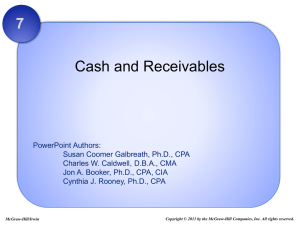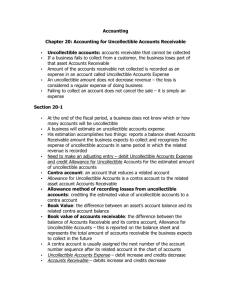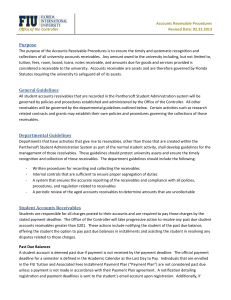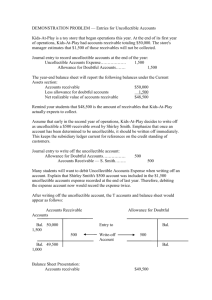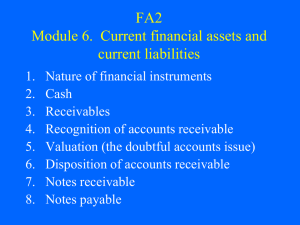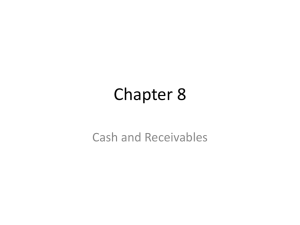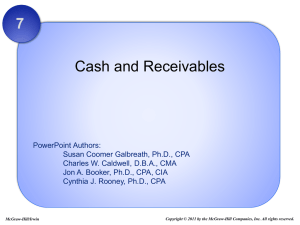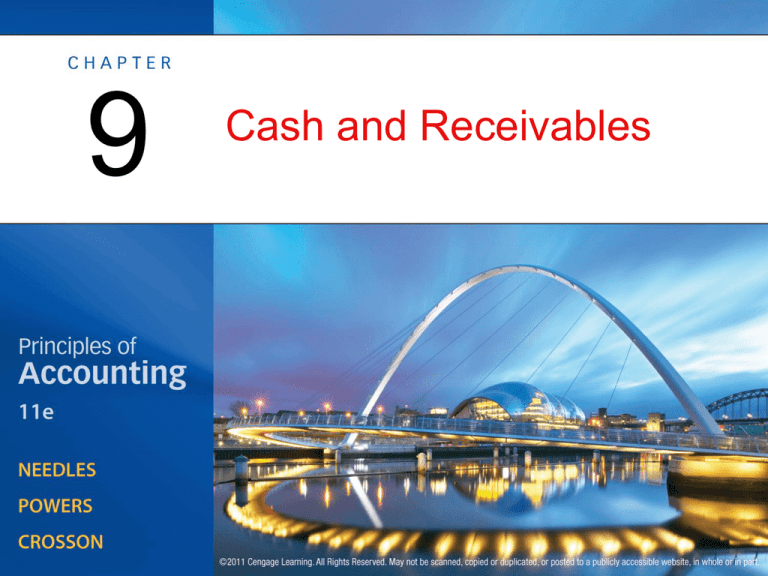
9
Cash and Receivables
Management Issues Related to Cash and
Receivables
OBJECTIVE 1: Identify and explain the
management and ethical issues related to
cash and receivables.
Key Ratios
• Receivable turnover
• Days’ sales uncollected
Figure 1: Seasonal Cycles and Cash
Requirements for an Athletic Sportswear
Company
Figure 2: Accounts Receivable as a Percentage of
Total Assets for Selected Industries
Figure 3: Receivable Turnover for
Selected Industries
Figure 4: Days’ Sales Uncollected for
Selected Industries
Figure 5: How Factoring Works
Management Issues Related to Cash and
Receivables
• There are five main management issues
related to cash and receivables.
–
–
–
–
–
Managing cash needs
Setting credit policies
Evaluating the level of accounts receivable
Financing receivables
Making ethical estimates of credit losses
Management Issues Related to Cash and
Receivables
• Cash
– The most liquid of all assets and is central to
the operating cycle
– Other short-term financial assets are accounts
receivable, notes receivable, and short-term
investments, all of which can be converted
readily to cash.
– Cash may include a compensating balance in a
bank account, which is not able to be spent and
must be disclosed on financial statements.
Management Issues Related to Cash and
Receivables
• Accounts receivable, or trade credit, are
amounts owed by customers for sales or
services and are current assets.
– Installment accounts receivable allow
customers to make a series of payments over
an extended period.
Management Issues Related to Cash and
Receivables
• The following measures of the
effectiveness of credit policies should be
compared with industry averages.
– Receivable turnover (net credit sales divided
by average net accounts receivable)
– Days’ sales uncollected (365 days divided by
the receivable turnover)
Management Issues Related to Cash and
Receivables
• Some companies finance receivables to
maintain financial flexibility.
– Establish a finance company
– Pledge accounts receivable
Management Issues Related to Cash and
Receivables
• Some companies finance receivables to
maintain financial flexibility. (cont.)
– Through securitization, group receivables in
batches and sell them at a discount to
companies and investors
– Discount (sell) notes receivable
Management Issues Related to Cash and
Receivables
• Some companies finance receivables to
maintain financial flexibility. (cont.)
– Factor (sell) accounts receivable
• Without recourse (e.g., Visa, MasterCard, American
Express) means that the factor bears the risk of loss.
• With recourse means that the seller bears the risk of
loss.
– A contingent liability is a potential liability that may
develop into a real liability depending upon a future
occurrence.
Management Issues Related to Cash and
Receivables
• Deliberately overstating or understating
earnings as a result of misrepresenting the
level of uncollectible accounts is a serious
ethical violation.
©2011 Cengage Learning All Rights Reserved. May not be scanned, copied or duplicate, or posted to a publicly accessible website, in whole or in part.
Cash Equivalents and Cash Control
OBJECTIVE 2: Define cash equivalents, and
explain methods of controlling cash,
including bank reconciliations.
Exhibit 1: Bank Reconciliation
Cash Equivalents and Cash Control
• Cash equivalents (e.g., CDs, U.S. Treasury
notes) are any security with a term of 90
days or less in which idle cash is invested.
Cash Equivalents and Cash Control
• Cash control methods
– Cash on hand should be kept in a fund, such as
a petty cash fund, operated on an imprest
system.
– Funds may be transferred from one account to
another without writing checks using electronic
funds transfer.
Cash Equivalents and Cash Control
• Explain why a bank reconciliation is
necessary
– Transactions possibly in company’s records
only:
• Outstanding checks
• Deposits in transit
Cash Equivalents and Cash Control
• Explain why a bank reconciliation is
necessary (cont.)
– Transactions possibly in bank’s records only:
•
•
•
•
SC
NSF checks
Miscellaneous charges and credits
Interest income
– Recording transactions after reconciliation
©2011 Cengage Learning All Rights Reserved. May not be scanned, copied or duplicate, or posted to a publicly accessible website, in whole or in part.
Uncollectible Accounts
OBJECTIVE 3: Apply the allowance method
of accounting for uncollectible accounts.
Exhibit 2: Analysis of Accounts
Receivable by Age
Figure 6: Two Methods of Estimating
Uncollectible Accounts
Uncollectible Accounts
• There are two methods of accounting for
uncollectible accounts.
– Journalize the write-off of an account under the
direct charge-off method.
Uncollectible Accounts
• There are two methods of accounting for
uncollectible accounts.(cont.)
– Journalize the year-end adjustment for
uncollectible accounts under the allowance
method.
• Estimate uncollectible accounts using the
percentage of net sales method. Any previous
balance in Allowance for Uncollectible Accounts is
irrelevant in making the adjusting entry.
Uncollectible Accounts
Uncollectible Accounts
Uncollectible Accounts
• Estimate uncollectible accounts using the accounts
receivable aging method. Any previous balance in
Allowance for Uncollectible Accounts is relevant in
making the adjusting entry.
Uncollectible Accounts
• There are two methods of accounting for
uncollectible accounts.(cont.)
– Journalize the write-off of a specific account
under the allowance method. The net realizable
value of Accounts Receivable is unchanged.
– Journalize the recovery of accounts receivable
written off under the allowance method.
Uncollectible Accounts
Uncollectible Accounts
Uncollectible Accounts
©2011 Cengage Learning All Rights Reserved. May not be scanned, copied or duplicate, or posted to a publicly accessible website, in whole or in part.
Notes Receivable
OBJECTIVE 4: Define promissory note, and
make common calculations for promissory
notes receivable.
Figure 7: A Promissory Note
Notes Receivable
• A promissory note is an unconditional
promise to pay a sum of money on demand
or on a certain date.
– The maker of the note records Notes Payable.
– The payee of the note records Notes
Receivable.
Notes Receivable
• The maturity value of an interest-bearing
note is the face value of the note (principal)
plus interest. For a non-interest-bearing
note, maturity value is equal to the face
amount (which, however, includes implied
interest).
• The maturity date and duration of note must
be either stated on the promissory note or
determinable from the information on the
note.
Notes Receivable
• Interest = principal × rate of interest × time
(length of note).
– For example, interest on $800 at 5 percent for
90 days is $10, which is computed by solving
$800 × (5 ÷ 100) × (90 ÷ 360). A 360-day year
is commonly used to simplify the computation.
If the length of the note were expressed in
months, then the number of months divided by
12 would constitute the time.
Notes Receivable
• The maturity value equals principal plus
interest.
• The interest on a note accrues by a small
amount each date of the note’s duration.
• When the maker of a note does not pay the
note at maturity, it is said to be a
dishonored note.
©2011 Cengage Learning All Rights Reserved. May not be scanned, copied or duplicate, or posted to a publicly accessible website, in whole or in part.





